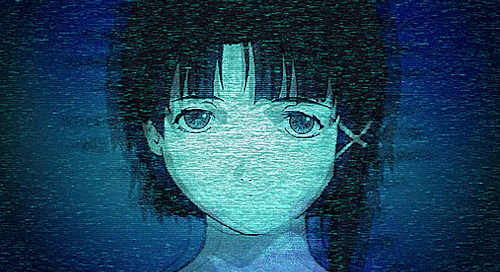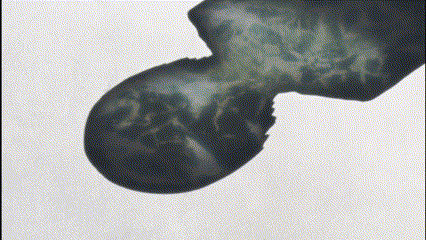In the late 1990s, a string of innovative and original productions transformed anime. Serial Experiments Lain was a part of this, but never gained the same place in popular culture as contemporaries like Neon Genesis Evangelion, Cowboy Bebop, or Ghibli films such as Princess Mononoke. SEL was far stranger and less accessible than other shows of ther period. It was interesting then, as its 25th anniversary approached, to observe a grassroots revival of interest in the show. Lain has been reborn through TikTok and Twitter, gaining an audience born years after the series aired. The buzz has been enough to even reform the band which had performed the soundtrack after 18 years.
In brief, and without spoilers: Serial Experiments Lain tells the tale of Lain Iwakura, a schoolgirl whose world becomes increasingly uncanny as she begins using the internet (referred to throughout as “The Wired”). An acquaintance commits suicide; men in dark suits follow her home; strangers recognise her; and Lain comes to question her own identity and that of people around her. Over 13 episodes, Lain moves further into The Wired, and boundary between the physical and online worlds starts to break down.
It is a excellent anime in itself. The design, direction and animation are still fresh today, and a sense of unease is sustained throughout the series. But the quality alone is not, I believe, the reason for the revival. What distinguishes Serial Experiments Lain is the way it explores and predicts how the internet would intersect with our lives, our identities, and our relationships. SEL predates Google, smartphones, Facebook – the web itself was 7 years old when SEL debuted.1 Despite this, despite the quarter century that has elapsed, despite the way the internet has reshaped our reality, no other work has engaged with the internet so seriously or perceptively.
For example: in Serial Experiments Lain is the “realness” of things encountered on The Wired is in constantly challenged. In 2023, this question has been answered without being asked. Any event that was unphotographed didn’t happen. Any placle that can’t be found on Google Maps is not there. A tragedy unrecorded never came to pass. The internet is not just a repository of knowledge, but a requirement to truly exist.
Of particularly currency is how Serial Experiments Lain addresses the bifurcation of identity the internet has imposed on us all. Our default understanding of “someone online” is that they are just a projection by an individual onto the internet. Our real selves look at the computer or phone and put out a persona that under our control. This might be a more-or-less representative depiction of the IRL-you (such as on Facebook or Instagram); it might be someone completely different you just pretend to be on the internet. SEL, back in 1998, suggested this dichotomy was incorrect. In SEL, online avatars take on an independent life of their own, and Lain is forced to ask what the “real you” actually means.
The distinction for own-name accounts is fairly trivial: our Instagram and LinkedIn versions are fitter, happier and more productive, but at least purport to be ourselves. Still, they are not fully under out control. Secret algorithms manage which posts are seen and unseen, so that the version that is encountered by others may seem to behave in a way quite different to how you imagine.
It is with Anon accounts that Serial Experiments Lain is most insightful. My Twitter account has 7,500 followers at time of writing. Some of my posts have had several million views. This is still a small account. By comparison, I would estimate I know less than 100 people personally – there are maybe two dozen I communicate with regularly. Almost nobody is aware of the opinions I freely express under my pseudonym. I am sure this generally true of almost every Anon account on social media. At this point, we must ask the same question Lain is confronted with: who is the real me? There is a version of me that is known to an order of magnitude more people, that expresses himself with great candour. If “realness” is defined by authenticity, or by popular consensus, or by contemporary documentation, the real me is not the one that works and eats and shops and sleeps. In SEL, investigating this question leads Lain to a bizarre denouement: if we can project ourselves into the Wired, could The Wired project itself into the physical world?
As The Wired becomes more powerful and more real, Lain’s surroundings become more uncanny and malleable. This is precisely what we to are experiencing in the 21st century. We used to tell ourselves that the internet is not real life, and that the attitudes and activity we see on social media does not translate into the wider world. It is increasingly obvious how out of date this position is. Like Lain, we see the unnerving trends bleeding out of the internet into our own personal lives. We dismiss the oddball ranting on Twitter until we hear the same words coming from a colleague’s mouth. Fringe trends from social media transforms politics and culture at a pace that bewilders the old world. The Wired reshapes the meatspace faster and faster. As SEL puts it:
“Let me give you one little warning. When it's all said and done, the Wired is just a medium for communication and the transfer of information. You mustn't confuse it with the real world. Do you understand what I'm warning you about?”
“You're wrong. The border between the two isn't all that clear. I'll be able to enter it soon. In Full range. Full motion. I'll translate myself into it. But don't worry: I'm still me.”
Serial Experiments Lain is an imperfect show. The pacing isn’t so much slow as glacial. At points it is confusing, weird, or plain corny. Technobabble intersperses with archive footage in ways Adam Curtis would find a bit much. But retro charm is not what has drawn millions back to Lain. It is rather the thrill of connecting, and seeing your own experience reproduced on the screen. Serial Experiments Lain remains a triumph of the animated form, and a clarifying lens for anyone reflecting on the way the internet intersects with their life.
The extent to which SEL is a product of another time is best felt through the surreal recording of an episode broadcast in the aftermath of 9/11, presumably as the scheduled programming was too jolly for the occasion.








(A very good essay!) I have always thought it interesting how Evangelion poses the "who is the real you" question just a few years before, but still in quite an 'analog' way, in the last years "before" the internet. Lain picks up that question and goes "you thought it was complicated then? Wait until you see how The Wired is going to multiply the problem a hundred-fold". It is a question withh a long arc, but a changing social context (sad to not see many works today continue to explore it as well, though they exist ofc).